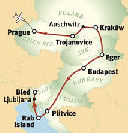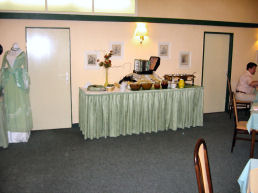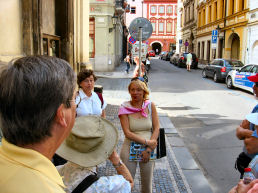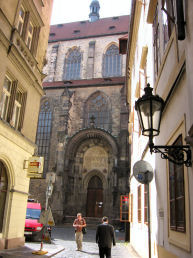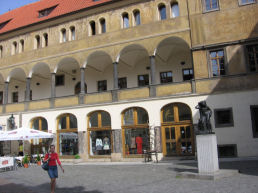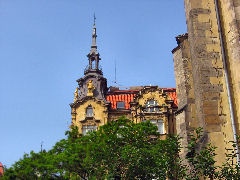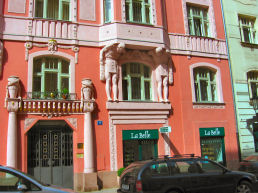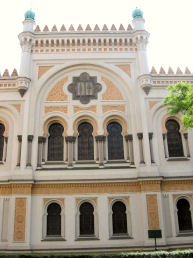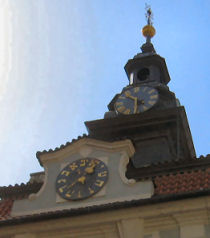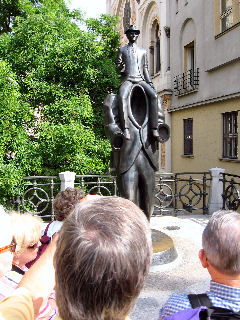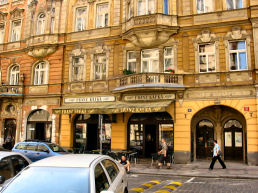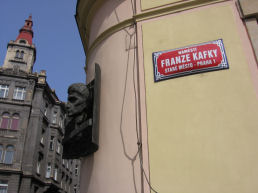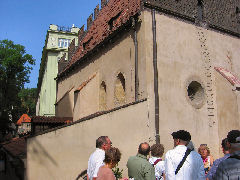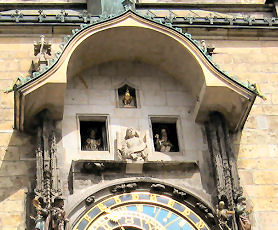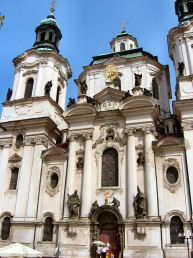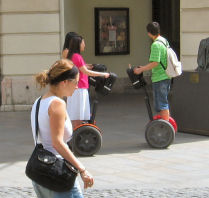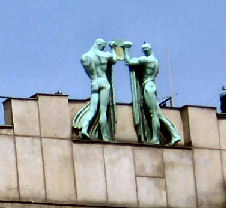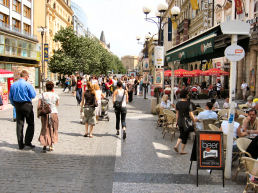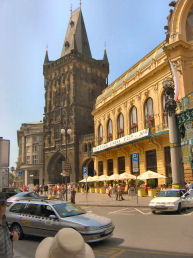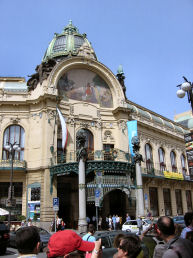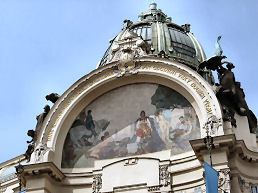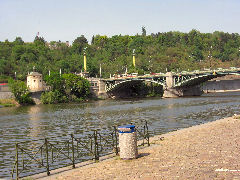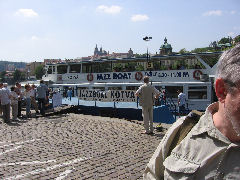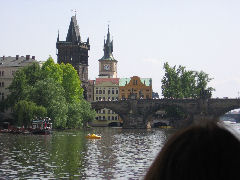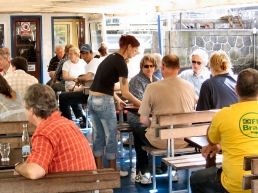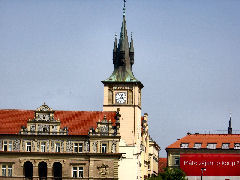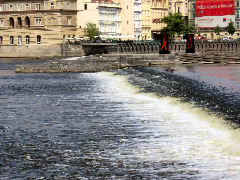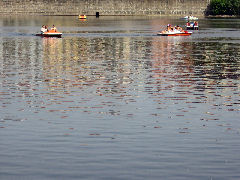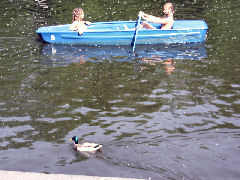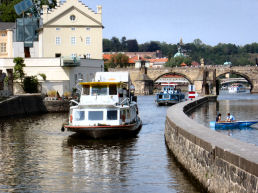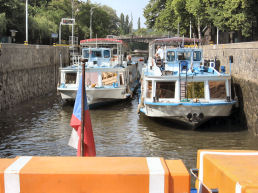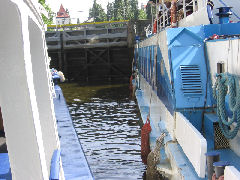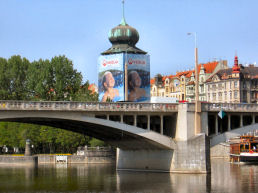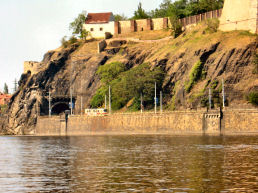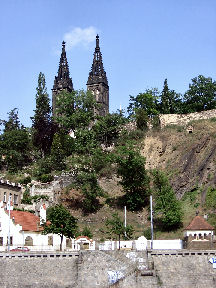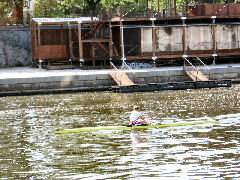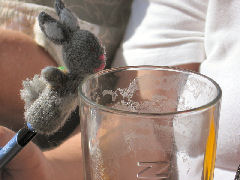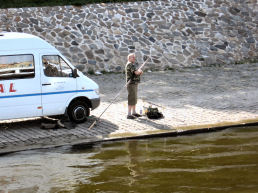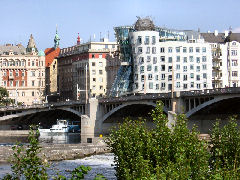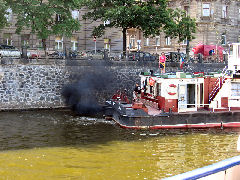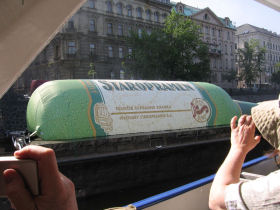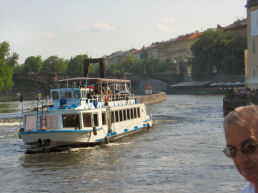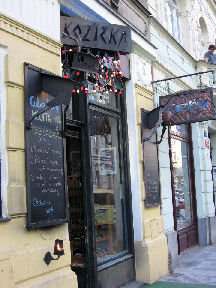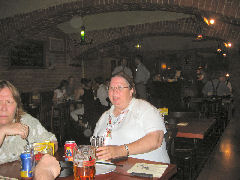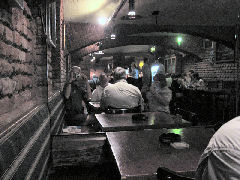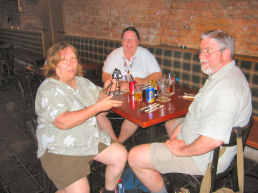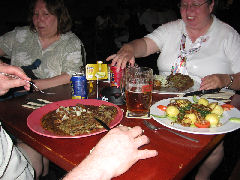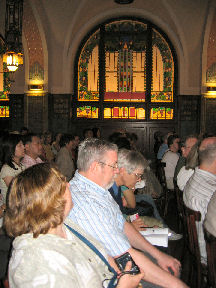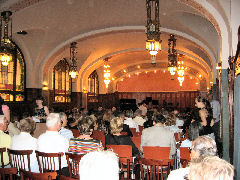I need not have worried about sleeping. The earplugs did the trick. I slept straight through from 1:30 to 6:40. I felt fine when I woke up.
The computer switch behaved itself this morning. The computer notified me that there were quite a few wi-fi hot spots within range, but I was unable to connect to any of them.
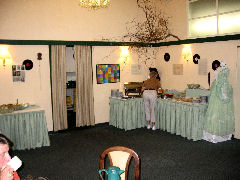
After breakfast we were guided on a walking tour of Old Town and the Jewish Quarter by Šárka Kačabová, a very knowledgeable native of Prague. Šárka had two very good teaching aids – a map of Prague and a timeline that correlated architectural periods with political and historical events. I was very impressed with the job that she had done on both of these. The production values were high, and she used them to great effect.
The tour began with a visit to the St. James church, an incredibly ornate place. Šárka pointed out that much of it was fake – the marble was really wallpaper, and most of the gold was just paint. It's over-the-top decorations impressed me a little less than many Italian churches, but I still might return for a longer look. I thought that Šárka said that they did not allow photos, but other people reported that the sign on the door only prohibited flash photography. I was interested in finding out if I could take decent photos without the flash. Since I forgot to bring the little tripod that Patti had bought me, I would need a steady hand.The previous evening Sue and Patti had already discovered the little puppet store in the square known as the Ungelt. We learned that the abundance of marionettes in Prague was due to the fact that the Hapsburgs had allowed puppet shows to be done in the Czech language. They assumed that anything for children was harmless. So, the Czech writers disguised their political commentaries in the trappings of children's shows in the same way that the writers of the TV show "Dinosaurs" did.Šárka referred to our tour guide as Zuzanka.
The Týn church that overlooked Old Town Square was constructed of sandstone. If they had kept it clean by sand-blasting it, the blocks would have been worn to nothing by now. So they just let it stay sooty. I thought that this strategy gave it a distinctive look. Šárka told us that Týn was a Celtic word meaning fortified place. The Celts were here in the 400's. The Czechs came a little later, but if Šárka said where they came from, I missed it.
The Jewish Quarter was a full-fledged walled-in ghetto in the northern part of Old Town. It had only one entrance and one exit. It was established shortly after the Fourth Lateran Council in 1215. That would propably make it Innocent III's work. Who else? As in Rome the Jewish men were forced to wear bizarre hats, and the women wore distinctive shawls.
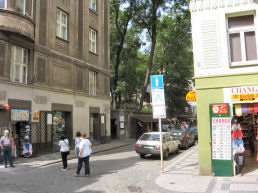
In the 1860's the Hapsburg Emperor Franz Joseph I finally released the Jews from these onerous requirements. In that decade the Hapsburgs granted lots of concessions throughout their territories in an effort to stave off a repeat of the wave of revolutions in 1848. In some cases it worked; in other cases it only postponed the inevitable.
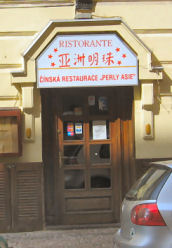
Šárka told us about the tourist boats that cruise up and down the Vltava river. Her opinion was that the two-hour cruise was a much better deal than the one-hour cruise.
The legend of the golem came from the Jewish Quarter of Prague. We stopped behind the temple in which the rabbi allegedly kept the monster.
Šárka revealed that King Wencelas, who was around in the 900's, was really only a duke. He was killed by his brother. The square that bore his name was really more of a long boulevard than a square.
The Prague Spring revolt in 1968 was put down by the Soviets. In 1989 ten thousand people met in Wenceslas Square to protest the Soviet occupation. This did not impress me as a very significant number; more than one hundred times that many turned out in Rome a few years ago to protest the invasion of Iraq. I had recently learned enough to suspect strongly that something was going on behind the scenes in 1989. If I had to guess, I would posit that Pope John Paul II was behind it.Šárka showed us the streets that represent where the moat just outside the Old Town's walls used to be. I meant to ask her when the moat was filled in, but I never did. The Museum of Communism is on the moat street, Napřikopě. The Mucha museum was a little way south of it. Sue expressed an interest in going to both of these museums if we could find the time.The tour ended at the Municipal House, the most prominent example of art nouveau architecture in Prague. It was right next to the old Powder Tower. Concerts were often held there especially during this period, the Prague Spring concert season. Susana said that the Elgar concert for tonight was sold out. I had to wonder who would want to listen to Elgar's music in Prague.
The tour group said goodbye for a day to Šárka. Susana then directed a game aimed at helping each of us to remember everyone else's name. Fortunately Sue and I were first; we were easily able to remember each other's names and Susana's. I always find this kind of thing tiresome and annoying. Maybe other people experienced more difficulty remembering people's names than I did.
Tom asked me if I had everyone's name memorized. I said that I had trouble remembering Ray's wife's name. Sue said that it was easy for her because she looked like Joan Sutherland. I said that La Stupenda was six foot tall and had long wispy hair. Sue said that she must have been thinking of that other opera singer that was on public TV all the time. She was referring to Beverly Sills.
Afterwards Sue went with Susana to find out about the train connections in her planned Slovak mission. Tom and Patti and I went to the large department store, Kotvo. We went up to the third floor, and I bought a new camera case. Everything in the electronics department was computerized. It was evidently leased; in fact, most of the store seemed to consist of small leased departments.
After an hour or so of down time, the four of us decided to take the cruise on the Vltava River. We walked north to the river and then turned west to the Čechov Bridge, the one that leads to the metronome. We found the ticket booth rather easily. Tom had just about enough cash to buy the four tickets on the Jazzboat. I did not even have enough korunas for one ticket.
Tom and Sue and I ordered Staropramen beers from the purple-haired waitress. Patti had an iced tea. They took credit cards, so I paid. They charged a 4 percent commission for the privilege. We sat on the top deck, as did everyone else. Fortunately for Sue, there was an awning that shaded us for the first half of the trip.
The boat sailed west and then turned south toward the Charles Bridge, on which I still had not set foot. There were pretty good views of the castle and St. Vitus's cathedral. As we approached the Mostlegil bridge, our boat had to get in line for the lock. We sat there for a half hour or so watching people in paddleboats and rowboats on the river. There were also quite a few ducks. I managed to get one picture of a couple of guys rowing a boat backwards with a duck in the foreground.
The Jazzboat finally got to enter the lock with three or four other ships. It only took ten minutes or so to pump in about eight feet of water. We then proceeded south past the island and the Jirakuv Most, where I managed to get some decent shots of the dancing house. The boat journeyed a little farther south past the tunnel before we turned around.
On the way back we encountered a tug boat and a barge carrying a large balloon shaped like a Staropramen beer bottle. An incredible quantity of pure black smoke was pouring out of the tug's engine. Although the tug reached the lock before we did, its captain allowed us to go through the lock before it, so we did not have to inhale its exhaust.
Two German couples sat across from us. I expected half of the people on the ship to light up cigarettes almost immediately, but the only person whom I observed smoking was one of the two guys across from us. One of the German women was wearing New Balance shoes, which I found rather surprising. I learned years ago that the first thing that many Europeans noticed about people was their shoes.
The cruise was quite relaxing. However, I was not sure that I agreed with Šárka's claim that the two-hour cruise was a better bargain. Most of the extra time was spent waiting to get into the lock.
On the other hand, I definitely did agree with Šárka's assessment that the Czechs needed to improve their performance as capitalists. Only one rather unenthusiastic waitress had been hired to serve the entire boatload of thirsty passengers. She never even got around to taking a second order of drinks on a two-hour cruise on a hot sunny day. Even inexperienced proprietors should realize that they want to move as much of that high-markup material as they possibly can. The idea of drink orders going unfulfilled would drive any self-respecting capitalist nuts.
From the shore we witnessed a peculiar event on one of the bridges. Some people were dumping sheets of white paper onto a boat passing below. Most of the paper ended up in the water. We never discovered the meaning of this ceremony.
After the cruise we walked up to Ars Musica, a CD store that also sold tickets to concerts. We bought tickets for a classical music concert at Municipal House that same evening. It was scheduled to start at 8:30, but, since the concert has open seating, we planned to get there at 8:10. Sue and I were accustomed to attending such concerts; we were a little surprised that Tom and Patti were interested in attending.
We ate supper at one of Šárka's recommended restaurants, Kozička, which means she-goat in Czech. We had to go downstairs and then go across the bar to reach the dining area. It was a nice place, and it was just what we were looking for. I had stuffed dumplings and spinach. Sue and Tom ordered the goulash and potato pancakes. They both really raved about the latter. Patti ordered späzel with ham and cheese. We all thought that the food was quite good. I took quite a few photos, including some experimental shots using the mirror that covered the wall on the far end of the restaurant.
Everything at the restaurant was computerized. The waiter even brought a wireless credit card processor over to our table. I had never seen this in the States. The Czechs seemed to be a lot more open to technology than the Italians. Maybe this could be explained by the high percentage of the Italian businesses have been in the same family for several generations.
We dressed up a little and then walked the three blocks to the Municipal House for the concert, which was held in a long room in the basement with curtains on a side. It was not really a concert hall; in fact, I think that it was actually the wine cellar. There was a small stage at one end and a couple of hundred wooden chairs. The front half was cordoned off and reserved for "VIP's." The four of us sat together near the front of the peon section. The seats were fine. Tom could not believe how long twenty minutes could take when one was waiting for a concert to begin. I had brought my guidebook with me to help me pass away the time before the performance. I found a likely candidate for the next day's lunch.The performers consisted of two violins, a viola, a cello, and a string bass. They also had a trumpeter (Vladislav Kozderka) and a soprano (Naděžda Chrobáková). They chose an excellent program: an air by Bach (played by the trumpeter), Dvořak's Humoresque, Gounod's Ave Maria sung by the soprano, a waltz from Tchaikowsky, part of Vivaldi's winter movement from The Four Seasons, part of the Moldau on the trumpet, the largo from Dvořak's New World, a dance from Smetana's The Bartered Bride, the song to the moon from Rusalka, and the opening to Eine kleine Nachtmusik.
The show stopper was the aria from Rusalka, one of my all-time favorites. I found it extremely moving to hear it sung by a native Czech speaker, and so did most of the audience. The soprano was called back for a personal encore. She sang Panis Angelicus, an unexpected selection that took me back to my days in parochial school. The main group also did an encore. Their choice was an equally strange one – the slow movement from Eine kleine nachtmusik.
Sue wanted to have the trumpeter's baby. Tom and Patti seemed to enjoy the evening well enough. It certainly was better than the last concert that we four attended together – a Bob Dylan performance in a rain storm at a minor league baseball field. We sat near third base line. Dylan was in center field. We could not even recognize the songs.
After the concert Tom and I wandered around looking for a bankomat. We finally found one on the south side of the moat street. Then Tom joined Sue for a (Czech) Budweiser at the beer garden that the Corcorans' room overlooked. Sue reported to me later that she could see Lyle walking around in his room.
While they occupied themselves with carousing and peeping, I said a rosary for world peace and then washed some of my clothes in the sink. This was not as easy to do without a bidet. Evidently bidets are not de rigueur in this portion of Europe. I also had to face the difficult problem of figuring out where to string the clothes line. I ended up using the light fixture to support one end.
After that I worked on my journal for a while. Then I inserted my earplugs, donned my eye mask, and headed for dreamland.
